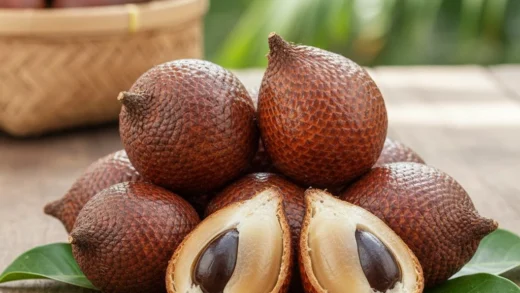Buah Merah

Introduction
Buah Merah (Pandanus conoideus), commonly known as the Red Fruit, is a tropical gem celebrated across Malaysia, Papua, and Eastern Indonesia. Its vibrant red pulp, rich nutritional profile, and distinctive flavor have made it a prized fruit in traditional cuisine and wellness practices. Beyond its culinary appeal, Buah Merah holds cultural significance, featuring in local rituals, festivals, and communal gatherings. Today, the fruit is recognized not only for its heritage value but also as a versatile ingredient in modern recipes, health drinks, and natural oils.
Origin
Buah Merah is native to Papua New Guinea and Eastern Indonesia, thriving in tropical lowlands and coastal regions. Belonging to the Pandanaceae family, its scientific name is Pandanus conoideus. Traditionally, indigenous communities have cultivated the fruit for its edible pulp and medicinal properties. Over time, its cultivation spread to Malaysia and other parts of Southeast Asia, owing to its adaptability and high nutritional value. Propagation is done via seeds and clonal methods, ensuring consistent quality for both culinary and commercial use.
Category
| Scientific Name | Family | Category | Type (Seasonality) |
|---|---|---|---|
| Pandanus conoideus | Pandanaceae | Tropical Fruit | Perennial; May–September |
Appearance
Buah Merah is typically 20–40 cm long, with a thick, scaly rind ranging from deep red to maroon. The interior pulp is bright red-orange, oily, and fibrous, enclosing small, inedible seeds. Its vibrant color and elongated shape make it immediately recognizable and visually striking.
Popular Varieties
| Variety | Local Name | Distinctive Features | Region of Prominence |
|---|---|---|---|
| Merah Besar | Buah Merah Besar | Large size, high oil content | Papua, Indonesia |
| Merah Kecil | Buah Merah Kecil | Smaller, sweeter pulp | Maluku Islands |
| Buah Merah Papua | Buah Merah Papua | Rich red coloration, high carotene | Papua New Guinea |
Preparation
Buah Merah can be enjoyed in multiple ways:
- Fresh: Sliced or scooped directly from the fruit.
- Snacks: Candies, preserves, or roasted pulp.
- Desserts: Cakes, puddings, ice creams, and pastries.
- Traditional Cuisine: Soups, stews, and local dishes.
- Beverages: Extracted as oil, smoothies, or health drinks.
Equipment
- Sharp knife for peeling
- Spoon or scooping tool
- Blender or grinder for puree or oil
- Strainer for juice or oil separation
- Heat-resistant container for cooking or processing
Taste
Buah Merah offers a rich, mildly sweet flavor with earthy undertones. Its natural oiliness gives it a creamy mouthfeel and subtle nutty notes, making it suitable for both sweet and savory dishes.
Texture
The pulp is fibrous yet smooth when processed. Fresh fruit has a firm and slightly coarse texture, while cooked or blended forms are silky and viscous.
Aroma
Buah Merah emits an earthy, nutty aroma with tropical undertones. The scent intensifies during cooking or oil extraction, enhancing both flavor and sensory appeal.
Cultural Significance
Buah Merah plays an important role in Malaysian, Papuan, and Indonesian traditions. It is commonly used in ceremonial rituals, communal gatherings, and festive dishes. The fruit symbolizes vitality, prosperity, and cultural continuity, reflecting the identity and heritage of local communities.
Regional Cultivation
| State/Region | Famous For | Harvest Period |
|---|---|---|
| Papua, Indonesia | High oil yield, vibrant pulp | May–September |
| Maluku Islands | Sweet, small fruits | June–August |
| Sabah, Malaysia | Culinary applications | May–July |
| Papua New Guinea | Medicinal and ceremonial use | May–September |
Social Context
Locals enjoy Buah Merah in markets, roadside stalls, and seasonal festivals. Fresh slices, processed oils, and preserves are widely consumed, highlighting the fruit’s role in daily life and traditional celebrations.
Nutritional Information (per 100g)
| Nutrient | Value |
|---|---|
| Calories | 210 kcal |
| Carbohydrates | 28 g |
| Protein | 2 g |
| Fat | 12 g |
| Fiber | 3 g |
| Vitamins | A, C, E, Beta-carotene |
| Minerals | Calcium, Iron, Potassium |
Health Benefits
- Supports eye health with beta-carotene
- Boosts immunity through vitamin C
- Provides heart-healthy fats
- Enhances energy and endurance
- Supports skin health and antioxidant protection
Dietary Restrictions
- Consume in moderation for high-fat diets
- Individuals with sugar sensitivity should control intake
- Digestive sensitivities may require caution
Allergens
- Rare nut-like sensitivities may occur due to oil content
- Generally safe for most populations
Cost
- Buah Merah Besar: USD 6–10 per kg
- Buah Merah Kecil: USD 5–8 per kg
- Processed oil: USD 15–25 per 100ml
Production & Export
Buah Merah is exported to health-focused markets in Asia, Europe, and North America. The fruit supports local economies, particularly in agriculture and functional food industries. Its oil is increasingly used in wellness products, cosmetics, and nutraceuticals.
Symbolism
Buah Merah symbolizes heritage, vitality, abundance, and authenticity. It represents cultural pride, communal celebration, and natural prosperity, bridging traditional practices with modern culinary innovation.








Comments are closed.